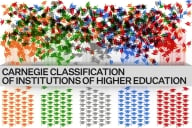You have /5 articles left.
Sign up for a free account or log in.
Liberal arts colleges, with varying degrees of urgency, are talking about the viability of their business models quite a bit these days. They are asking questions about whether the most expensive of these institutions (even with their generous student aid policies) will face price resistance from families, and whether the less wealthy and prestigious of these institutions can survive, among others.
Lucie Lapovsky, an economist who has served as president of a private institution (Mercy College) and vice president for finance at another (Goucher College), set out to explore these issues by looking at three private, coeducational, residential liberal arts colleges. The three (kept anonymous in the study to encourage full release of data) are similar in their size (1,560 to 1,648 enrollments), mission, academic offerings, the breadth of student activities and athletics, and loyal alumni. Students at all three institutions say that they picked them for their personalized approach to education and close contact with faculty members. Students give all three institutions high marks. (Lapovsky consults with colleges on their financial strategies; she said only one of the three colleges is a client.)
But the three institutions are also very different: in what they charge students, in their expectations of faculty, in their support for student activities, and in their admissions competitiveness. While there is much talk from some business consultants suggesting most private colleges are about to fall apart, and analyses comparing the traditional liberal arts college model to some sort of no-frills model (students getting instructed online for free or whatever scenario is in favor at the moment), the three colleges in Lapovsky's study may better reflect the range of choices for liberal arts colleges today. They aren't all falling apart. And It's not a matter of no frills, but of what students and professors expect. And about how much families are willing to pay for distinguishing characteristics of various institutions.
Lapovsky labeled the three institutions in her study, reflective of parts of the liberal arts universe, as Platinum, Gold and Silver. By most outside measures, their success in higher education reflects their names, with Platinum the most competitive in admissions and enrolling more of the students who are most sought by colleges. Platinum is also doing much better at keeping a balanced gender ratio among students (a major concern of liberal arts colleges), while Gold and Silver are losing their men. But Silver was much more successful in attracting low-income students. Consider the following statistics on students:
| Platinum | Gold | Silver | |
| % of Applicants Admitted | 15% | 39% | 54% |
| % of Accepted Applicants Who Enroll (Yield) | 40% | 30% | 19% |
| % of Students Who Are Male | 49% | 46% | 41% |
| % of Students Receiving Pell Grants | 17% | 12% | 30% |
Lapovsky noted in an interview that there is an assumption that the more prestigious institutions have the resources to achieve all the main goals in admissions, including attracting low-income students. But that's not necessarily the case. The endowments of Platinum, Gold and Silver, respectively, are $1.5 billion, $150 million and $50 million, and yet Silver is much more successful at attracting low-income students. (While graduation rates are highest at Platinum, those at Silver are strong for institutions educating large numbers of disadvantaged students.)
Platinum also charges more (sticker price for tuition, room and board and fees) than anyone else, but Gold yields more tuition revenue per student.
| Platinum | Gold | Silver | |
| Tuition | $39,762 | $41,090 | $26,200 |
| Total costs (including fees, room and board) | $53,300 | $52,650 | $36,850 |
| Tuition discount rate | 45% | 30% | 48% |
| Net tuition revenue per student | $21,869 | $28,763 | $13,624 |
These differences then suggest the question of how institutions with such different financial resources (both in endowment and tuition revenue) can offer substantially the same programs. All three institutions spend more on instruction than on any other expense category, but given the size of their budgets, that means that academic spending is far greater at Platinum. And it means that even in areas of student services -- where Silver, as usual, is outspent -- the gaps are smaller.
What the different spending levels largely reflect, Lapovsky said, is class size and course load. Platinum's standard course load for a full-time faculty member is 2-2 (two courses each semester). Gold's is 3-2 (having moved down from 3-3 a decade ago). Silver is 4-4, with a goal of moving to 4-3 in the next few years. (The three institutions make minimal use of adjuncts.)
Platinum teaches more classes in the 2-9 student range than do the other two, but Silver doesn't teach any classes with enrollment over 50, while Platinum offers five such courses a semester, and Gold offers six. For all three institutions, the most common class size is between 10 and 19 students. But it costs Silver much less to offer those courses because of the larger course loads.
And yet, as Lapovsky's research shows, the trend among liberal arts colleges is to reduce course loads, not increase them. There is also a significant gap in faculty salaries among the institutions, with those with the lowest teaching loads earning the most. The average salary for a full professor is $135,000 at Platinum, $94,000 at Gold, and $70,00 at Silver.
If one wants to bring down the cost of liberal arts colleges, "I think these data say you have to look at the academic side of the house and talk about workload," Lapovsky said. "I was floored by the similarity of curriculum [at the three colleges], but the Silver people are teaching twice as many courses as the Platinum and they are making much less money."
The issue isn't that faculty members at Platinum aren't working, she said. It's that elite liberal arts colleges have steadily ratcheted up research expectations, so that those on a 2-2 course load are pushed to publish more or win more grants. Lapovsky said that while there are no doubt valuable contributions being made by some of this research, it is not of the type that is changing disciplines. But still, the time spent on the research makes it hard to talk about course load. As long as elite liberal arts college tell their faculty members to do more research, they will do so, she said.
Another area that jumped out at Lapovsky, she said, was spending levels on student activities, where she found concerns among campus officials at Platinum and Silver. At Silver, she said, students said that the college supported student activities in theory, but offered few resources. So students in various organizations complained that they spent more time raising money for activities than actually doing those activities.
At Platinum, the students are quite happy because any time they think of an idea "and request money, it's just handed to them." She said that some administrators and faculty members at Platinum "reflected to me that they are over-coddling their students."
Jane Wellman, executive director of the National Association of System Heads, is a pioneer and advocate of the kind of work Lapovsky did on these colleges -- looking at what they actually spend their money on. She said that the study has implications for how liberal arts colleges might save money, but also illustrates the difficulty the institutions may face in taking such actions.
"Platinum is spending money in lots of places where they could reduce costs and prices and not touch outcomes," she said via e-mail.
But she added: "F. Scott Fitzgerald and Sophie Tucker were right about the rich. Money begets money, as in, you have it, you'll spend it, and most of the time won't have much to show for it other than the pleasure of getting and spending it. The Medici family motto probably factors in here too -- 'money to get the power, power to guard the money.' "








